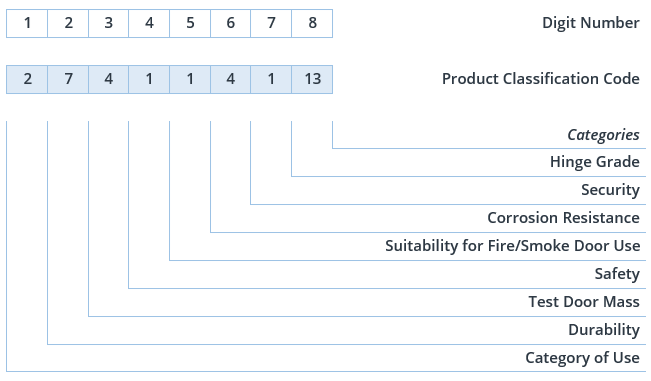
Fire Door Standards & Regulations
This article will provide you with a working understanding of the CE Mark and how to read the product classification code.EN Standards for Building Hardware
The CE Mark is a mandatory requirement for construction products placed on the market after 1 July 2013. The CE Mark is only applicable, however, where there is a relevant European standard for the particular component.
Component or associated element
Can the item be separately CE marked?
Relevant product standard
Door leaf
No
No hEN
Doorframe
No
No hEN
Single axis hinges
Yes
BS EN 1935
Locks and latches
Yes
BS EN 12209
Electro-mechanical locks
Yes
BS EN 14846
Controlled closing devices
Yes
BS EN 1154
Electric hold open devices
Yes
BS EN 1155
Door co-ordinators
Yes
BS EN 1158
Panic exit devices
Yes
BS EN 1125
Emergency exit hardware
Yes
BS EN 179
Electrically controlled emergency exit systems
Yes
BS EN 13637
Powered pedestrian door systems
Yes
BS EN 16005
Glass
– Laminated (NB as special fire-resistant glass)
– Modified toughened soda-lime-silica glass
– Soda-lime-silica - Georgian wired
– Toughened borosilicate
– Glass ceramic
– Laminated (NB as special fire-resistant glass)
– Modified toughened soda-lime-silica glass
– Soda-lime-silica - Georgian wired
– Toughened borosilicate
– Glass ceramic
Yes
BS EN 14449
BS EN 12150
BS EN 572
BS EN 13024
BS EN 1748
Seals (e.g edges and protection hardware elements)
No
No hEN
Glazing sealants
No
No hEN
Ventilators and grilles
No
No hEN
Letter plates
No
No hEN
Viewing spy holes
No
No hEN
Product Classification Code
The applicable EN standard classifies the product characteristics of each type of building hardware used on fire doors by using a multiple digit coding system. A similar classification applies to all building hardware product standards so that complementary items of hardware can be specified to, for instance, a common level of corrosion resistance, category of use, etc. Each digit refers to a particular feature of the product measured against the standard's performance requirements.
The multiple digit coding system assists in the selection of building hardware that is compatible with the configuration of the fire door assembly on which it is intended to be used. For example, in selecting a suitable hinge, the following product characteristics might be selected as most suitable for the intended application from the eight categories available in BS EN 1935:
Category of Use
Suitable for medium duty use
Durability
200,000 test cycles
Test Door Mass
Suitable for use on doors weighing up to 60kg
Suitability for Fire/Smoke Door Use
Suitable for fire/smoke resistant door assemblies
Safety
Satisfies the essential requirements of safety in use
Corrosion Resistance
Very high resistance to corrosion
Security
Suitable for applications requiring a degree of security
Hinge Grade
Suitable for use on fire doors weighing up to 120kg

The entry in the first box of the product classification code is referred to as Digit 1, the entry in the second box is referred to as Digit 2, etc. The 8 digits in the code correspond to the following 8 categories:
Digit 1
Category of use
Digit 2
Durability
Digit 3
Test door mass
Digit 4
Suitability for fire/smoke door use
Digit 5
Safety
Digit 6
Corrosion resistance
Digit 7
Security
Digit 8
Hinge grade
Digit 1 - Category of use
Four categories of use are identified:
- Grade 1: light duty
- Grade 2: medium duty
- Grade 3: heavy duty
- Grade 4: severe duty
Digit 2 - Durability
Three grades are identified for single-axis hinges manufactured to this European standard:
- Grade 3: 10,000 test cycles, for light duty hinges on windows only
- Grade 4: 25,000 test cycles, for light duty hinges on windows and doors
- Grade 7: 200,000 test cycles, for medium, heavy and severe duty hinges on doors only
Digit 3 - Test Door Mass
Eight door mass grades related to single-axis hinges are identified in this European standard.
- Grade 1 - 10 kg
- Grade 2 - 20 kg
- Grade 3 - 40 kg
- Grade 4 - 60 kg
- Grade 5 - 80 kg
- Grade 6 - 100 kg
- Grade 7 - 120 kg
- Grade 8 - 160 kg
Two grades of suitability are identified for single-axis hinges:
- Grade 0: not suitable for fire/smoke resistant door assemblies
- Grade 1: suitable for fire/smoke resistant door assemblies
Single-axis hinges are required to satisfy the essential requirements of safety in use. Therefore, only grade 1 is identified. Digit 6 - Corrosion resistance
Five grades of corrosion resistance are identified in accordance with EN 1670:
- Grade 0: no defined corrosion resistance
- Grade 1: mild resistance
- Grade 2: moderate resistance
- Grade 3: high resistance
- Grade 4: very high resistance
Two grades of security are identified for single-axis hinges:
- Grade 0: not suitable for use on burglar-resistant door assemblies
- Grade 1: suitable for applications requiring a degree of security
Fourteen grades are identified in this European standard but only 4 are suitable for use on fire doors:
Grade
Usage
Test Cycles
Door Mass
Grade 11
Door
200,000
80kg
Grade 12
Door
200,000
100kg
Grade 13
Door
200,000
120kg
Grade 14
Door
200,000
160kg
Antrim, Armagh, Carlow, Cavan, Clare, Cork, Derry, Donegal, Down, Dublin, Fermanagh, Galway, Kerry, Kildare, Kilkenny, Laois, Leitrim, Limerick, Longford, Louth, Mayo, Meath, Monaghan, Offaly, Roscommon, Sligo, Tipperary, Tyrone, Waterford, Westmeath, Wexford, and Wicklow
Copyright © 2023 TheFireDoorInspector.ie. All Rights Reserved.






